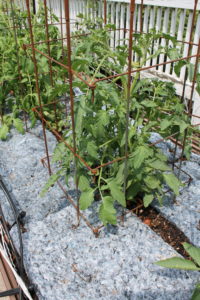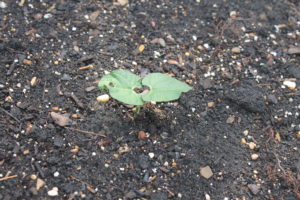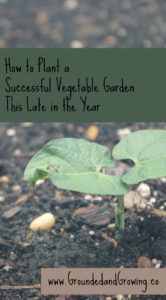Planting with the fall season in mind gives all of us a second shot at a successful vegetable garden.
Funny how life gets in the way of our best intentions.
I had high hopes for my vegetable garden this year. After all, I’m not working full-time anymore, so I should have all kinds of free time, right? Ha! I think I’m busier now more than ever. There’s just so much I want to do. And so much that needs to be done!
I planted my garden in a somewhat timely fashion, mostly in May, our prime vegetable planting time. Our raised beds needed some soil added to them this year. That delayed planting. Add in various events in the month of May, from birthdays to anniversaries to graduations plus a week-long class I took, and that delayed it further. Plus planting anything with my kids in tow, while entertaining for all involved, takes many times longer than if I’m by myself.
Spring planting happened in a very piecemeal fashion at our house this year. But it happened.

My tomatoes are one of the only things in my vegetable garden looking good so far this year. We are experimenting and using the shredded cotton insulation from our Plated meal subscription boxes as mulch. So far they are keeping the weeds down and holding in just enough moisture.
About half of my garden looks good. The other half is struggling, which I unfortunately expected. We discovered about three years ago that a nearby tree’s roots have invaded half of our raised beds. I’m supposed to know about gardening, but I never anticipated this development. We’ve chopped out the roots out as much as possible and gardened on.
Last year the garden on that side never amounted to anything. The plants just never really got going. I chalked it up to gardening with a newborn in the house.
But I keep coming back to those darn roots. I think they’re just sucking the life out of that side of the garden. It’s not lack of sunlight– that side of the garden has a lot of shade in the morning, but it’s in the blazing hot sun from about noon onward.
Reluctantly, I planted that side of the garden this year, and again the plants are struggling. I noticed that side of the garden is dry a lot faster than the other, making me think the tree is just drinking up all the available water. Only about 3 green bean seeds sprouted out of at least 50 I planted! My cucumbers, cantaloupe and zucchini are all limping along. Last year our zucchini plants died! I should have taken the hint last year when even zucchini died!
A friend of mine was also lamenting the wrenches that life had thrown into her great gardening intentions. She didn’t get a single thing planted. She asked me if there was anything she could plant now– so she could at least harvest something, anything from her garden!
But what can you plant in July?!?
The sad truth is, with 4th of July right around the corner, we’re right on the tail edge of planting longer season crops like melons, tomatoes and squash. If you could find some transplants that are larger than usual, you might have a shot at harvesting something by the end of the season. As long as no more wrenches get thrown into the mix, weather-wise, life-wise, or both.
The brighter side of this sad state of affairs is we are right on time, maybe even a couple of weeks early, for planting a fall vegetable garden. We think about fall for pumpkins and winter squash, but forget with a little planning we can have a whole extra season of vegetable gardening that includes other vegetables.
Mid-July through about mid-August is the perfect time to plant seeds for cool weather crops like broccoli, Brussels sprouts, and cauliflower. I personally think these crops all taste better when grown in the fall. As nights become cooler, especially with a light frost, these plants release sugars and the vegetables taste sweeter.
One trick for fall gardening is….
getting the seeds sprouted before the night temperatures dip too much and the soil begins to cool off, which slows down or stops seeds from germinating.
The other tricky part of fall gardening is greens like lettuce, collards, and spinach are all great fall crops, but if you plant them too early, with too much hot weather ahead of them, they will quickly bolt (form flowers/seeds and develop bitter flavor). In my personal experience, planting these crops in mid-August gives them enough heat and time to get sprouted and established before the nights begin to cool off. By that time the cool weather helps prevent bolting and you are ready to harvest.
Other suggestions for a fall garden include: turnips, beets, kohlrabi, carrots, peas and radishes. Radishes are another crop I would put off planting until mid-August or so because too much heat will negatively affect their flavor– they tend to become very hot and spicy.

One of my sad, solitary green beans that managed to emerge in the garden bed invaded by tree roots. Hopefully I can get my green bean fix by planting a new crop in containers.
Green beans are a warm season crop but they mature quickly so you can plant them late in the season and still have something to harvest. Green beans typically are ready for harvest in 50 to 60 days. If you can get seeds planted by mid-August, you should be able to harvest beans before frost, which usually arrives by mid-October in central Illinois.
Another option…
I’m going to try is planting my fall garden crops in containers. I’m thinking if I set them on top of the raised beds that were invaded by tree roots, I can determine once and for all if the tree roots are taking all the moisture and nutrients, or if that side of the garden actually has too much shade.
There are a lot of options for containers. Just about any good sized (12 inches or more) pot will work. Even a 5-gallon bucket with holes drilled in the bottom is adequate for most plants. Just make sure the bucket didn’t hold anything toxic to you or to plants before using it for planting!
I plant my containers according to the square foot gardening method, which bases the number of plants and their spacing on a 12 inch by 12 inch square (1 square foot). You will need to do some math (or at least a good visual estimate) of how many square feet of planting area you have per container. This square foot gardening website has a ton of helpful information on individual vegetables and planting schedules tailored to your specific location.
The bottom line?
Anyone that has gardened for any length of time will tell you that there are good years, and there are bad years for gardens. Gardeners tend to be a stubborn lot and will not let a bad year stop them from future gardening.
Sometimes the good or bad gardening year has everything to do with life events and nothing at all to do with the weather or anything directly related to growing plants. And that’s ok.
I’m probably going to have to admit that one side of my vegetable garden is not fit for growing plants anymore. The mere thought of moving my raised beds somewhere else makes me tired and frustrated. But if I want a garden, I need to figure out a new approach.
Maybe you tried to grow too much this year and it all got out of hand and morphed into a weedy mess. Maybe life got too crazy and you didn’t plant a single thing.
Planting a fall vegetable garden is like a second chance. Use the coming weeks as an opportunity to get at least one thing planted. My friend is right– having at least one thing that you can say you grew yourself can make all the difference in the world.
If you liked this post, please subscribe to Grounded and Growing today and receive your copy of “15 Tips to Become a '15 Minute Gardener'” so you can spend less time working ON your garden and more time enjoying being IN your garden.! It’s absolutely free. When you join the Grounded and Growing community, you’ll finally take the garden off your “To-Do” list and allow yourself time to enjoy your garden and savor the peace and serenity there. I tell subscribers about new posts as soon as I hit ‘publish’ and send weekly-ish updates on what’s going on in my garden– good, bad AND ugly.

All Rights Reserved. © 2017 Jennifer Schultz Nelson
Nice! I enjoy your stories, probably because I can relate so well.
Thanks.
Thanks Cheryl!
In Mansfield, IL, we are so very dry! Something is wilted every day, and I am spending a few hours every day watering. I try to put on enough water at one time so the plant is ok for a few days, but I planted a few new perennials and a few annuals that need water frequently. As for a fall garden, I did plant a new hill of zucchini last week, and one seed has germinated. I just watered that tiny seedling!
So if you are getting rain. please take note of where you are from Mansfield, IL (between Champaign and Bloomington on I74) and send some my way.
We are so dry too! You might try adding mulch if haven’t already, or you can use those moisture retaining crystals that are normally mixed with potting mix in outdoor beds if you have a really bad situation.
I’ve heard that sinking a copper barrier between a tree and your garden will prevent the tree roots from invading the garden. Do you know anything about this?
I haven’t seen anything about a copper barrier, but I have read about using copper sulfate crystals dissolved in water for tree roots in septic systems or other pipes.